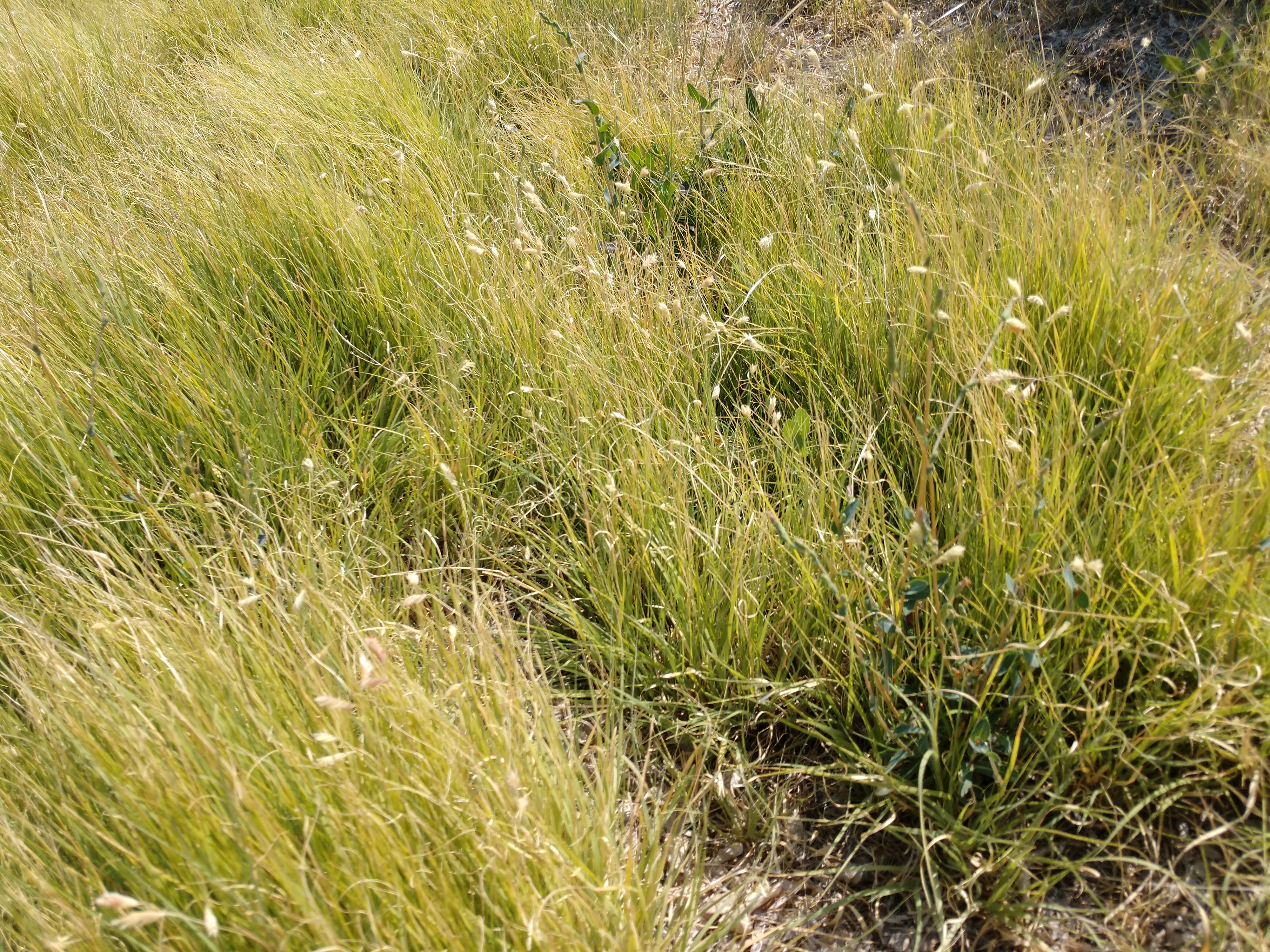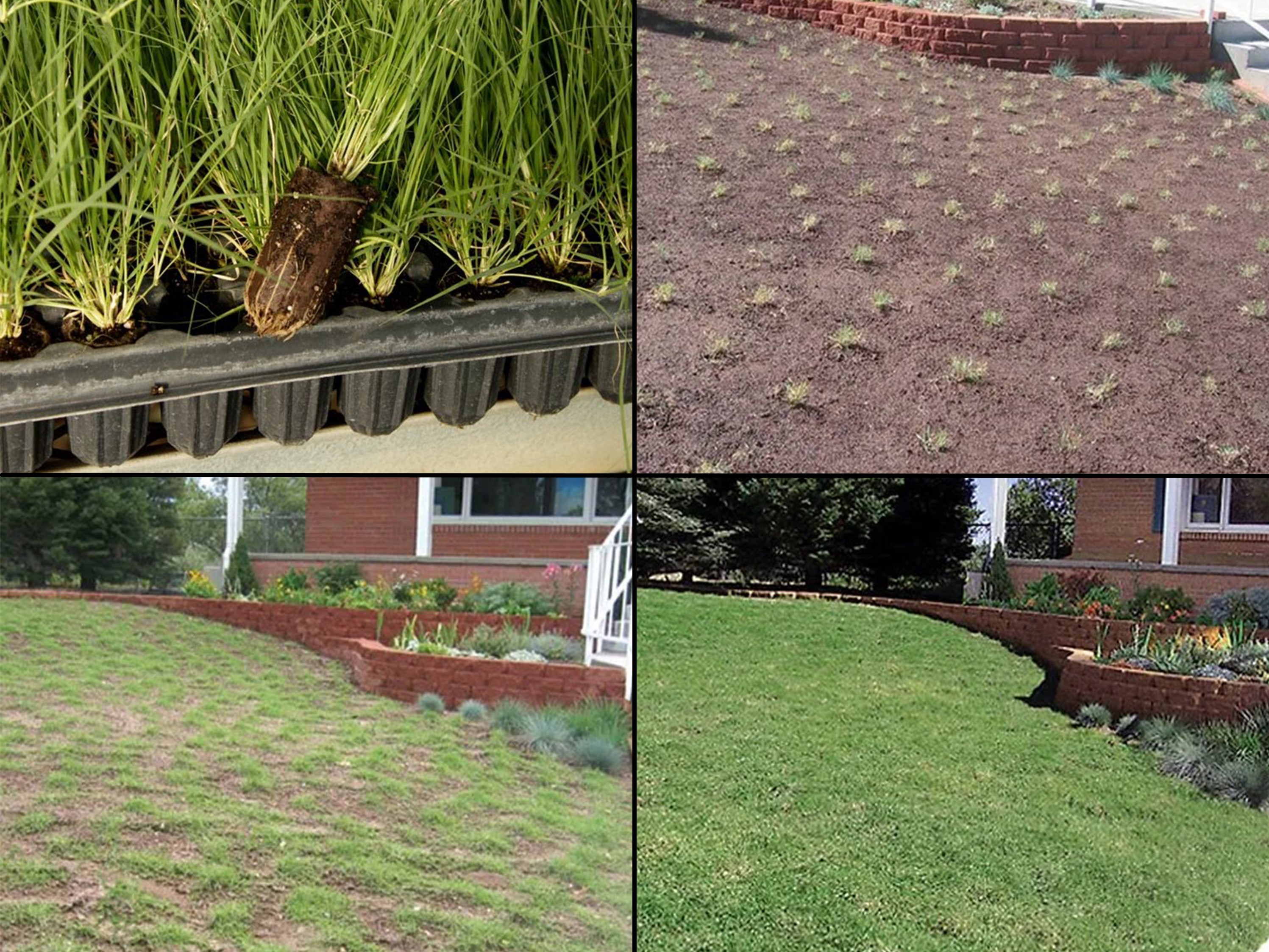 Drought Tolerant Buffalograss - June 23, 2021 Jeff Schalau, Agent, Agriculture & Natural Resources University of Arizona Cooperative Extension, Yavapai County Buffalograss (Buchloe dactyloides or Bouteloua dactyloides) is an excellent drought tolerant grass that can be used to create a lawn, informal meadow area, or to stabilize soil. It is native of Arizona found in small, isolated populations in Coconino and Gila Counties, but is much more common in the Great Plains from Montana to Minnesota and south to New Mexico, Texas, and Louisiana. This is one of the grasses that great herds of buffalo once grazed on and formed the sod early settlers used to build their houses on the prairie. Buffalograss is a low growing, warm season perennial. It can tolerate prolonged drought and extreme temperatures. The blue-green leaves of unmowed plants are commonly 8-10 inches and have very fine hairs on both upper and lower surfaces. The hairs are not obvious but this adaptation decreases air movement across leaf surfaces lowering the potential for water loss. Buffalograss is dioecious: individual plants are either male or female. The female cultivars (available as sod and plugs) are more compact (some as short as 4 inches) than the plants that originate from seed which will produce both male and female plants. Buffalograss spreads by stolons (above ground runners). Each node on a stolon is a growing point that can take root and produce a new plant where it comes in contact with soil. At a glance, it looks similar to bermudagrass, but upon close inspection, buffalograss has no underground rhizomes. Buffalograss can be controlled and contained easily. However, it cannot effectively compete with bermudagrass. Buffalograss can be established by sowing seed, planting plugs (small plants), or installing sod. Seeding is the least expensive. When purchasing, ask if the seed has been stratified (cold treated for 6-8 weeks) or chemically treated to break dormancy. If it has not, then it may not germinate until the following year. To prepare the seedbed, till the ground, rake smooth, remove rocks or debris on the surface, then roll with a water filled roller (these can be rented). Sow the seed in May or early June – if sown after July 15, it may not establish before winter. After sowing, rake the seedbed to bury the seed, roll it another time to ensure good seed-to-soil contact, and cover with a thin layer of weed-free compost. Sowing rates vary with your goals. Four to six pounds of treated seed per 1,000 square feet should germinate in 7-10 days and grow into a dense stand (lawn) in several months if given adequate irrigation. Do not over irrigate buffalograss after establishment. Planting plugs is relatively easy, but a bit more work. Plugs (as well as sod) should be planted in late May or early June. Prepare your planting area as described above. Plugs can be purchased from online sources. Plugging simply requires transplanting them on 12-18” centers throughout the lawn area. The closer the plugs are spaced, the more quickly the area fills in. If establishing a lawn, a pre-emergent herbicide is strongly recommended during the establishment period to keep the weeds from growing and reduce competition. Industrious gardeners can grow their own plugs. This is really the best way to establish buffalograss for erosion control. It can also be transplanted from established stands in the warm season. To do this, dig up a small patch (8” x 8”) keeping the soil/root mass together. This clump can be cut into smaller plugs and planted. New transplants should be regularly irrigated until established. Gardeners should also note that buffalograss is not the same a buffelgrass (Pennisetum ciliare). Buffelgrass is an invasive weed that was brought to North America from Africa and the Middle East. Buffalograss is a low maintenance turf that is best used in low traffic areas. It should not be mowed short - three inches or higher is recommended. Fertilization is optional and applications should not exceed two pounds of nitrogen per 1,000 square feet. One inch of water per week is adequate to maintain an established buffalograss lawn and excessive water encourages bermudagrass encroachment. Like bermudagrass, buffalograss will become dormant when the weather cools off in fall and winter. During this dormant period, it will be straw-colored and should not be overseeded with any annual grasses. I have included several additional resources below. You can follow the Backyard Gardener on Twitter – use the link on the BYG website. If you have other gardening questions, email the Master Gardener Help Desk in Prescott (prescottmg@gmail.com) or Camp Verde (verdevalleymg@gmail.com) and be sure to include your name, location, and phone number. Find past Backyard Gardener columns or provide feedback at the Backyard Gardener web site: https://cals.arizona.edu/yavapai/anr/hort/byg/. Images  Buffalograss (Bouteloua dactyloides) line drawing showing female plants above and male plants below (From: USDA-NRCS PLANTS Database / Hitchcock, A.S. (rev. A. Chase). 1950. Manual of the grasses of the United States. USDA Miscellaneous Publication No. 200. Washington, DC).
Buffalograss (Bouteloua dactyloides) line drawing showing female plants above and male plants below (From: USDA-NRCS PLANTS Database / Hitchcock, A.S. (rev. A. Chase). 1950. Manual of the grasses of the United States. USDA Miscellaneous Publication No. 200. Washington, DC). Unmowed buffalograss (Bouteloua dactyloides) shown during the warm season (Photo by Jeff Schalau, University of Arizona).
Unmowed buffalograss (Bouteloua dactyloides) shown during the warm season (Photo by Jeff Schalau, University of Arizona). Buffalograss (Bouteloua dactyloides) plugs and a planting that shows the process of filling in. Weeds can become an issue when planting plugs and herbicides should be used sparingly and only with spot treatments. In the author's opinion, buffalograss is best used in less formal seetings where a "meadow" appearance is acceptable (plug photo from: californiabuffalograss.com and planting photos from: www.highcountrygardens.com).
Buffalograss (Bouteloua dactyloides) plugs and a planting that shows the process of filling in. Weeds can become an issue when planting plugs and herbicides should be used sparingly and only with spot treatments. In the author's opinion, buffalograss is best used in less formal seetings where a "meadow" appearance is acceptable (plug photo from: californiabuffalograss.com and planting photos from: www.highcountrygardens.com).Additional Resources Buffalograss, Texas Cooperative Extension aggie-horticulture.tamu.edu/plantanswers/turf/publications/buffalo.html Buffalograss Lawns, Colorado State University Extension extension.colostate.edu/topic-areas/yard-garden/buffalograss-lawns-7-224/ Buffalograss Lawns, K-State Research and Extension bookstore.ksre.ksu.edu/pubs/mf658.pdf |